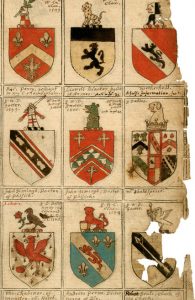PRESS RELEASE
Contact: Shakespeare Oxford Fellowship
Tom Regnier, President
info@shakespeareoxfordfellowship.com

The New York Times on June 29 published an article about the discovery by Heather Wolfe, a Folger Library curator, of new documents related to the application for a coat of arms by William Shakespeare of Stratford-upon-Avon. The Times article suggests that the discovered documents are somehow evidence – even “a smoking gun” – proving that the man from Stratford did indeed write the works that have been attributed to him. But the attempt to pass off these documents as new and decisive evidence is nothing more than an exercise in smoke and mirrors.
One of the documents identifies the Stratford man as a “player” (actor). To anyone familiar with the authorship question, this is nothing new. Most authorship doubters have long accepted the premise that the Stratford man was involved in theatre, at least as an actor. But they note that no contemporary evidence identifies him as a writer of any kind. What is stunning about the Times article, however, is the way that it attempts to “spin” this discovery of evidence of acting into evidence of authorship. The article quotes Stratfordian professor James Shapiro, who has examined the documents:
The new documents, Mr. Shapiro added, also come with a nice bonus: they clearly refute skeptics who continue to argue — to the deep exasperation of most scholars — that William Shakespeare of Stratford-upon-Avon was not actually the author of the works attributed to him.
“It’s always been clear that Shakespeare of Stratford and ‘Shakespeare the player’ were one and the same,” Mr. Shapiro said. “But if you hold the documents Heather has discovered together, that is the smoking gun.”
Note the way in which the two paragraphs above subtly shift from one issue to another. In the first paragraph, the question is whether the Stratford man wrote the works of Shakespeare. The article states that the newly discovered documents “clearly refute” the idea that the Stratford man was not the author, but it doesn’t say how.
Then in the second paragraph, the issue shifts to whether the Stratford man was an actor. Mr. Shapiro says that it’s always been clear that he was an actor and that this is a “smoking gun.” But if it’s always been clear, how is this a smoking gun? Shapiro does not explain how proving that a person was an actor proves that he was a playwright. In the context of the article, most readers will come away with the impression that these documents are evidence that the Stratford man was a writer when they are merely evidence that he was an actor, nothing more.
The Times article uncritically reports Shapiro’s remarks without questioning their leap in logic. Furthermore, the article fails to ask the crucial question: if the Stratford man was actually a playwright-poet, why didn’t he mention that as a qualification for receiving a coat of arms? Playwright-poet Michael Drayton was given one. Surely, writing would be a better credential for attaining a coat of arms than merely being an actor. If William of Stratford actually wrote plays and poems, why didn’t the College of Arms refer to him as Shakespeare the Playwright or Poet, rather than the “Player”?
For many decades, adherents of the traditional, but flawed, Stratfordian theory have employed such misdirection to avoid having to explain away the improbability of their theory that some of the world’s most literate dramatic works, filled with evidence of the author’s knowledge of law, medicine, astronomy, the classics, heraldry, military tactics, and many other subjects, were written by a man who is not known to have ever gone to school, written a letter, or owned a book, whose parents and children were illiterate, and whose signatures suggest that he had difficulty writing his own name.
It is time for the press, especially such a distinguished newspaper as the New York Times, to start rolling up its journalistic sleeves and actually investigate both sides of this issue, as it used to do when William Niederkorn wrote for the Times. Today, the Times appears to be either a dupe or an accomplice of the usual smoke and mirrors techniques that the Shakespeare establishment is using to shield its defective fable from scrutiny.
[posted July 5, 2016]


